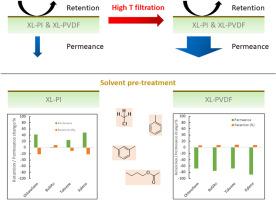高温过滤和溶剂预处理对交联聚偏二氟乙烯和聚酰亚胺耐溶剂纳滤膜的影响
IF 8.4
1区 工程技术
Q1 ENGINEERING, CHEMICAL
引用次数: 0
摘要
研究了交联聚偏二氟乙烯(XL-PVDF)和聚酰亚胺(XL-PI)膜在耐溶剂纳滤(SRNF)应用中的高温过滤性能。在 25 °C 至 80 °C 的温度范围内,在四种与工业相关的极性溶剂(甲苯、二甲苯、氯仿和乙酸正丁酯)中对膜进行了测试。使用极性探针分子(5,10,15,20-四(3,5-二叔丁基苯基)卟啉(TBPP,1064 Da))评估了温度对膜性能的影响,结果表明,随着温度的升高,渗透率会增加,这是由于溶剂粘度会降低,膜聚合物链的柔韧性会增强。这种效应在两种聚合物体系之间存在明显差异。高温过滤后,室温(RT)过滤显示在二甲苯、BuOAc 和甲苯中的保留率稳定,但在氯仿中的保留率下降。为了研究过滤前溶剂处理的影响,在接触甲苯、二甲苯、BuOAc 和氯仿前后进行了苏丹黑 (SB) / 氯仿过滤。令人惊讶的是,这种溶剂处理会对聚合物产生特定的影响:XL-PVDF 的渗透率增加,而 XL-PI 的渗透率降低。XL-PVDF 的保留率保持不变,但 XL-PI 的保留率略有增加。总的来说,这两种膜都表现出卓越的热稳定性和溶剂稳定性,但影响却大不相同。本文章由计算机程序翻译,如有差异,请以英文原文为准。

Impact of filtration at elevated temperature and solvent pre-treatment on crosslinked polyvinylidene difluoride and polyimide solvent-resistant nanofiltration membranes
The high temperature filtration performance of crosslinked polyvinylidene difluoride (XL-PVDF) and polyimide (XL-PI) membranes in solvent-resistant nanofiltration (SRNF) applications was studied. The membranes were tested in four industry-relevant, apolar solvents (toluene, xylene, chloroform, and n-butyl acetate) over a temperature range from 25 °C to 80 °C. The temperature effect on membrane performance was evaluated using a polar probe molecule (5,10,15,20-tetrakis(3,5-di-tert-butyl phenyl)porphyrin (TBPP), 1064 Da), showing that permeance increased with rising temperature due to the anticipating reduced solvent viscosity and enhanced flexibility of the membrane polymer chains. This effect varied clearly between the two polymer systems. After the high-temperature filtration, room-temperature (RT) filtrations demonstrated stable retention in xylene, BuOAc, and toluene, but a decrease in chloroform The membranes exhibited excellent long-term stability, retaining their quasi-intact filtration performance over a full week of operation. To investigate the impact of a pre-filtration solvent treatment, Sudan black (SB)/chloroform filtrations were done before and after exposure to toluene, xylene, BuOAc, and chloroform. Quite surprisingly, such solvent treatment resulted in a polymer-specific impact: an increased permeation for XL-PVDF and a decreased permeation for XL-PI. Retentions were constant for XL-PVDF but slightly increased for XL-PI. Overall, both membrane types showed excellent thermal and solvent stability, but the impact was very different.
求助全文
通过发布文献求助,成功后即可免费获取论文全文。
去求助
来源期刊

Journal of Membrane Science
工程技术-高分子科学
CiteScore
17.10
自引率
17.90%
发文量
1031
审稿时长
2.5 months
期刊介绍:
The Journal of Membrane Science is a publication that focuses on membrane systems and is aimed at academic and industrial chemists, chemical engineers, materials scientists, and membranologists. It publishes original research and reviews on various aspects of membrane transport, membrane formation/structure, fouling, module/process design, and processes/applications. The journal primarily focuses on the structure, function, and performance of non-biological membranes but also includes papers that relate to biological membranes. The Journal of Membrane Science publishes Full Text Papers, State-of-the-Art Reviews, Letters to the Editor, and Perspectives.
 求助内容:
求助内容: 应助结果提醒方式:
应助结果提醒方式:


